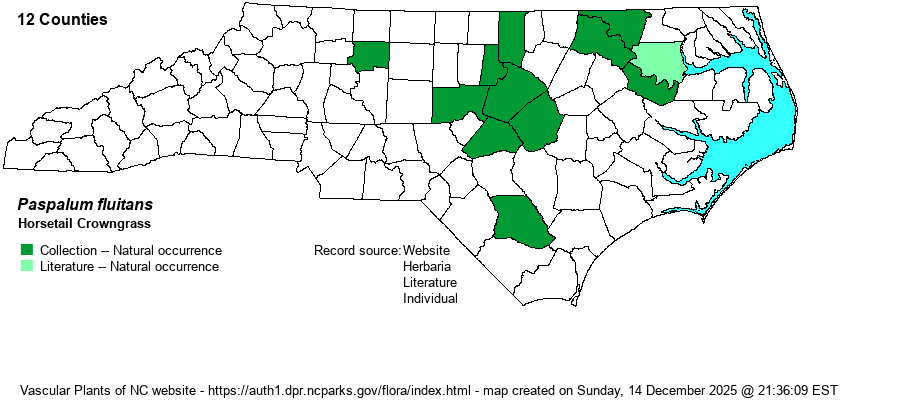| Section 5 » Order Cyperales » Family Poaceae |
Show/Hide Synonym
| taxonName | relationship | relatedTaxonName | relatedTaxonRefText | relComments |
|---|
|
|
|
|
|
|
|
| Paspalum fluitans | = | Paspalum repens | Flora of North America (1993b, 1997, 2000, 2002a, 2002b, 2003a, 2004b, 2005, 2006a, 2006b, 2006c, 2007a, 2009, 2010) | | | Paspalum fluitans | = | Paspalum repens | Godfrey and Wooten (1979, 1981) | | | Paspalum fluitans | = | Paspalum repens | Small (1933, 1938) | | | Paspalum fluitans | = | Paspalum repens | | | | Paspalum fluitans | = | Paspalum repens | Wunderlin & Hansen Flora of Florida (3) | | | Paspalum fluitans | = | Paspalum repens | Silveus (1942)=Y. Key based closely on FNA and on Banks (1966). | | | Source: Weakley's Flora |
|
| Author | (Elliott) Kunth | |
| Distribution | Mostly lower Piedmont and inner northern Coastal Plain. Known from the Cape Fear, Eno, Meherrin, Neuse, Tar, and Roanoke river systems. The Forsyth County specimen is from Winston Salem in 1827 (at DUKE).
MD to KS, south to FL and TX; tropical America. | |
| Abundance | Rare to uncommon; populations are locally distributed. It is likely the species is under-collected, especially in the Roanoke River system, as there are numerous VA records. The website editors feel that S2 is a more reasonable State Rank for NC, rather than the NCNHP's current S1, considering the number of counties with specimens (10+), plus two more based on other sources. This is a Significantly Rare species. In the Amazon basin this species forms enormous colonies, eventually breaking off and floating downstream as huge rafts that support other plants, insects, birds, etc. | |
| Habitat | Brownwater river shores, mud bars, and in very shallow water. Also backup channels and depressions in brownwater floodplain forests. |
| Phenology | Flowering and fruiting September-October. | |
| Identification | This is one of only two NC crowngrasses in which the inflorescence rachis has broad wings that cover or hide the spikelets. The other is P. dissectum, which differs in its leaf blades being less than 6 mm wide (vs. greater than 6 mm wide in P. fluitans). It also is one of the few Paspalum species in NC with many inflorescence branches (20+). | |
| Taxonomic Comments | A synonym is P. repens.
Paspalum is a genus of more than 300 species, found mostly in the New World. The genus is quite easily identified by the neat row of spikelets along each side of a flattened rachis (inflorescence branch), and also by the hemispherical outline of each spikelet. In some species there are only 2 such inflorescence branches, paired at the stem summit; in most of our species there are 3-4 branches; and in a few there may be many. Keys ask whether spikelets are paired or not -- that is, at each node on each side of the rachis there are pairs of spikelets on tiny stalklets. Care must be taken with a hand lens to make sure there are 2 stalklets at each node, as frequently one of the two spikelets will not grow. Non-paired or single spikelets will clearly have only a single stalklet per node. | |
| Other Common Name(s) | Water Paspalum, Horsetail Paspalum | |
| State Rank | S1 [S2] | |
| Global Rank | G5 | |
| State Status | SR-P | |
| US Status | | |
| USACE-agcp | | |
| USACE-emp | | |

